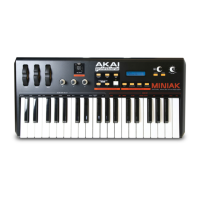10
3. Start new Multi?
Pressing the DATA DIAL at this option creates a new Multi named with the Sequence's name and a "+" in
front (e.g. "+Liner" and "+Bobbetty") and, if a Multi with this name already exists, a number at the end (e.g.
"+Liner2" and "+Bobbetty2").
4. Sequence program
Choose the Program that the Sequence will use to play its notes. In order to quickly jump between program
categories, you can hold down the [SEQUENCES] button and press the white keys labeled with category
names.
Another way of setting the Sequence's Program is to bring it over from Programs Mode. Press
[PROGRAMS] to enter Programs Mode, and find the Program that you want. Then, hold down
[PROGRAMS] and press [SEQUENCES], and the Sequence's Program will be set. This works in the other
direction as well–hold down [SEQUENCES] and press [PROGRAMS] to bring the Sequence's Program over
to Programs mode, perhaps for some quick editing.
5. Length
Select one of 1/4, 1/2, 1, 2 or 4 bars.
The Sequence will always play from the first note of the first
bar. So, if you select a value shorter than the current one,
the latter parts of the Sequence will be truncated. If you
select a value longer than the current one and the latter part
of the Sequence does not contain any notes, the new notes
at the end of the Sequence will be empty.
6. Grid
Choose 8, 12, 14, 16, 20, 24, or 32 steps per bar, or choose
unquantized. Shortening the scale decreases the quantizing
resolution. You're more likely to hear double notes and
simpler syncopations at low values.
"Straight-ahead" feels tend to result from using 8, 16, and 32
steps per bar. Swing and shuffle feels tend to result from
choosing 12 or 24 steps per bar. But you can also create
some different Sequences by using fractions of bars along
with less obvious grid values, like 14 and 20.
7. Type
Choose sequence or arpeggio. See "Sequence Types:
Arpeggios & Sequences" above for more information.
8. Span (arpeggios only)
Choose a span ranging from single note – in which the note
you press on the keyboard will be the only note that plays – to
one that plays up, down, or up-and-down through 1, 2, 3, or 4
octaves.
Length and Grid quantizin
The MINIAK records your playing at a
very high resolution. The length and grid
settings that you select for playing back
your Sequences are used to non-
destructively quantize those recordings.
So, if you record a four-bar Sequence and
change its length later to 1/4 bar, the
MINIAK will only play a fraction of your
Sequence, but it will remember the whole
thing. If you want to change the length
back to four bars at any time, the
complete Sequence will still be available.
Similarly, Sequence rhythms are
quantized using the grid setting, but the
underlying information remains
untouched. So, as you cycle through
different grid settings, you're likely to hear
different syncopations and "feels"
emerge.
Four Beats per Ba
All MINIAK Sequences have four beats
per bar.
You can still create odd-meter rhythms. It
just takes a little calculation and a
willingness to ignore the tempo
indications given by the [TAP TEMPO]
button.
For instance, one way to create a 3/4 feel
is to combine a length of 1/2 bar with a
grid of 24 steps. That will give you a total
of 12 steps to work with.
Ignore the display's "6 + 6" grouping.
Think "4 + 4 +

